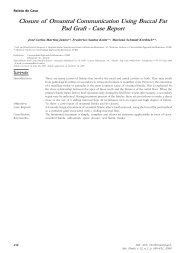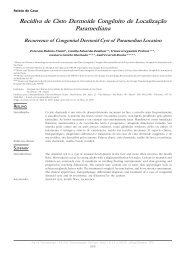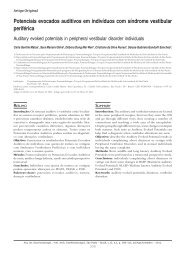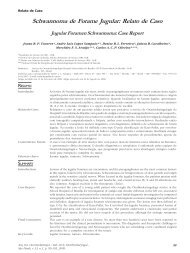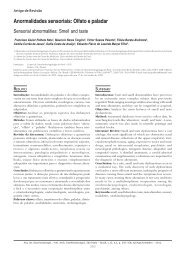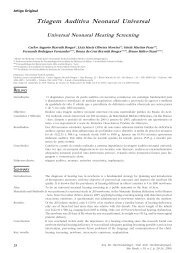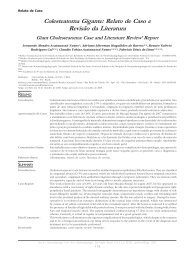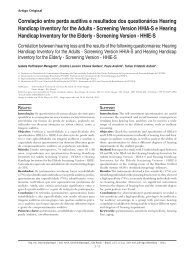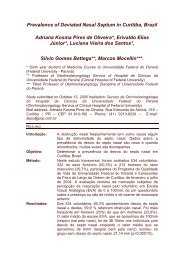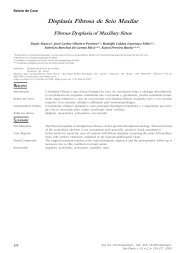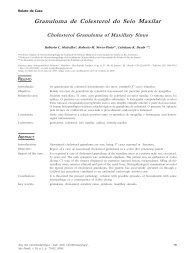Middle and Inner Ear Malformations in Two Cases of ...
Middle and Inner Ear Malformations in Two Cases of ...
Middle and Inner Ear Malformations in Two Cases of ...
You also want an ePaper? Increase the reach of your titles
YUMPU automatically turns print PDFs into web optimized ePapers that Google loves.
Orig<strong>in</strong>al Article<br />
<strong>Middle</strong> <strong>and</strong> <strong>Inner</strong> <strong>Ear</strong> <strong>Malformations</strong> <strong>in</strong> <strong>Two</strong> <strong>Cases</strong> <strong>of</strong><br />
Velocardi<strong>of</strong>acial Syndrome<br />
Alfredo Tabith Junior*, Ra<strong>in</strong>er Guilherme Haet<strong>in</strong>ger**, Fern<strong>and</strong>o Leite de Carvalho e Silva***,<br />
Monica de Castro Gudmon****.<br />
* Master’s degree. General Director DERDIC_PUCSP.<br />
** Doctoral Degree. Radiologist – Imag<strong>in</strong>g Doctor - Hospital Beneficência Portuguesa de São Paulo.<br />
*** Graduation <strong>in</strong> Medic<strong>in</strong>e. Otorh<strong>in</strong>olaryngologist – Phoniatrist at DERDIC/PUCSP.<br />
*** University Diploma <strong>in</strong> Phonoaudiology. Phonoaudiologist at DERDIC/PUCSP.<br />
Institution: Divisão de Educação e Reabilitação dos Distúrbios da Comunicação da Pontificia Universidade Católica de São Paulo - DERDIC/PUCSP Med Imagem -<br />
Hospital Beneficência Portuguesa de São Paulo.<br />
São Paulo / SP - Brazil<br />
Mail address: Alfredo Tabith Junior – Rua Dra. Neyde Apparecida Sollitto, 435 – São Paulo / SP - Brazil - Zip Code: 04022-040 – Fax: (+55 11) 5908-8009 – E-mail:<br />
alfredo.tab@uol.com.br<br />
Article received on January 14, 2008. Approved on March 19, 2009.<br />
SUMMARY<br />
Objective: To describe audiometric characteristics <strong>and</strong> middle <strong>and</strong> <strong>in</strong>ner ear malformations <strong>in</strong> two patients with<br />
velocardi<strong>of</strong>acial syndrome.<br />
Method: Audiometric evaluation, computerized tomography <strong>of</strong> the temporal bones <strong>and</strong> analysis <strong>of</strong> DNA for<br />
multiple markers <strong>of</strong> 22q11 region were performed <strong>in</strong> two patients with cl<strong>in</strong>ical signs <strong>of</strong> velocardi<strong>of</strong>acial<br />
syndrome.<br />
Results: Conductive hear<strong>in</strong>g loss related to chronic otites media <strong>and</strong> middle <strong>and</strong> <strong>in</strong>ner ear malformations were<br />
found, the latter with the use <strong>of</strong> reformations based on multislice acquisitions on <strong>of</strong> the computerized<br />
tomography <strong>of</strong> the temporal bones.<br />
Conclusion: We consider it to be highly important to carry out a thorough evaluation <strong>and</strong> monitor<strong>in</strong>g <strong>of</strong> the hear<strong>in</strong>g<br />
evolution, as well as the occurrence <strong>of</strong> symptoms related to the vestibular function <strong>in</strong> patients with<br />
velocardi<strong>of</strong>acial syndrome. From the radiological po<strong>in</strong>t <strong>of</strong> view, attention should be given to the use<br />
<strong>of</strong> high quality techniques for the tomographic study <strong>of</strong> temporal bones.<br />
Keywords: ear, hear<strong>in</strong>g loss, velocardi<strong>of</strong>acial.<br />
Intl. Arch. Otorh<strong>in</strong>olaryngol.,<br />
São Paulo, v.13, n.1, p. 83-86, 2009.<br />
83
84<br />
INTRODUCTION<br />
Characteristic facial features, congenital cardiac<br />
anomalies, cleft palate <strong>and</strong> learn<strong>in</strong>g disabilities, are all major<br />
characteristics <strong>of</strong> the velocardi<strong>of</strong>acial syndrome, described<br />
<strong>in</strong> some patients by SEDLÁCKOVA(1) <strong>and</strong> outl<strong>in</strong>ed by SHPRINTZEN<br />
et al (2). New phenotypic alterations <strong>of</strong> this syndrome<br />
have been described <strong>in</strong> the meantime (3-5). Although<br />
considered as one <strong>of</strong> the most frequent syndromes associated<br />
with cleft palate (6), it is not frequently recognized <strong>in</strong> the<br />
pediatrics practice. It’s caused by delection <strong>of</strong> the long arm<br />
<strong>of</strong> the chromosome 22 (22q11).<br />
Recently, middle <strong>and</strong> <strong>in</strong>ner ear malformations have<br />
been described <strong>in</strong> VCFS. Patients with hear<strong>in</strong>g loss associated<br />
with otitis media <strong>and</strong> with external ear malformations are<br />
described (7-8). The first reference to a primary defect <strong>of</strong><br />
the ossicular cha<strong>in</strong> was made <strong>in</strong> 2003, <strong>in</strong> a child with signs<br />
<strong>of</strong> the VCFS <strong>and</strong> 22q11.2 delection (9), from whom was<br />
found primary lung disgenesia along with congenital<br />
conductive unilateral hear<strong>in</strong>g loss, due to malformation <strong>and</strong><br />
subluxation <strong>of</strong> the left stapes, therefore, a conductive<br />
hear<strong>in</strong>g loss not related to otitis media, which is very<br />
common <strong>in</strong> this syndrome. <strong>Middle</strong> <strong>and</strong> <strong>in</strong>ner ear<br />
malformations were foud <strong>in</strong> two children with VCFS. One<br />
<strong>of</strong> them showed a Mond<strong>in</strong>i type cochlear malformation, an<br />
abnormal shape <strong>of</strong> the ossicles, with fusion <strong>of</strong> the malleus<br />
with the <strong>in</strong>cus <strong>and</strong> a monopodal stapes. The other child<br />
showed a congenital middle ear malformation with fixation<br />
<strong>of</strong> the malleus on the left annulus tympanicus, <strong>and</strong> a<br />
common cavity bilaterally between the vestibule <strong>and</strong> the<br />
lateral semicircular canal (10).<br />
This article aims at describ<strong>in</strong>g <strong>and</strong> characteriz<strong>in</strong>g the<br />
middle <strong>and</strong> <strong>in</strong>ner ear malformations found <strong>in</strong> two Brazilian<br />
boys with the VCFS.<br />
METHOD<br />
This paper was approved by Comitê de Ética em<br />
Pesquisa da PUCSP, protocol nº 261/2008.<br />
Subjects: <strong>Two</strong> boys with cl<strong>in</strong>ical signs <strong>of</strong> VCFS, at the<br />
ages <strong>of</strong> 4.7 <strong>and</strong> 6.7 years old.<br />
Procedures: Audiological evaluation, <strong>in</strong>clud<strong>in</strong>g pure<br />
tone audiometry, timpanometry, acoustical reflex, <strong>and</strong><br />
Computerized Tomography (CT) <strong>of</strong> temporal bones. In<br />
both, analyses <strong>of</strong> DNA sample with markers <strong>of</strong> 22q11<br />
region were performed. A Toshiba Aquilion-slice<br />
thickness 0.6mm tomograph, an Interacoustics AC33<br />
audiometer, <strong>and</strong> an Interacoustics AZ-7 middle ear<br />
analyser were used.<br />
RESULTS<br />
Tabith Junior A<br />
Patient 1 is a boy at the age <strong>of</strong> 6.7 years old, son <strong>of</strong><br />
nonconsangu<strong>in</strong>eous parents. He was born by cesarean,<br />
after a 41-week pregnancy. No family antecedents. He<br />
showed a submucous cleft palate, which was operated<br />
when he was 2.6 years, with good functional result. The<br />
neuropsychomotor development was normal. He shows<br />
cl<strong>in</strong>ical signs <strong>of</strong> VCFS, without cardiac defects. The DNA<br />
sample analyses from the patient <strong>and</strong> his parents, with five<br />
markers, revealed the delection <strong>of</strong>, at least, one marker <strong>in</strong><br />
the 22q11.2 region, which confirms the VCFS diagnosis.<br />
The audiogram shows air tone thresholds <strong>of</strong> 15dB<br />
HL at 250, 500, 1000 Hz, 20dB HL at 2000 <strong>and</strong> 4000Hz <strong>and</strong><br />
25dB HL, 60dB HL <strong>and</strong> 70dB HL (respectively at 4000,<br />
6000 <strong>and</strong> 8000 Hz) <strong>in</strong> the right side. Air tone thresholds <strong>of</strong><br />
15dB HL at 250 <strong>and</strong> 500 Hz, 20 dB HL at 1000 <strong>and</strong> 2000<br />
Hz, 25dB HL at 4000 Hz <strong>and</strong> 40dB HL at 6000 <strong>and</strong> 8000<br />
Hz <strong>in</strong> the left side. Bone tone thresholds <strong>of</strong> 5dB HL at 500<br />
e 1000 Hz, 0dB HL at 1000 Hz <strong>and</strong> 10 dB HL at 2000 <strong>and</strong><br />
4000 Hz. SRT was 35 dB HL <strong>in</strong> the right <strong>and</strong> 30 dB HL <strong>in</strong><br />
the left. WRS was <strong>of</strong> 100% at 60 dB bilaterally. Timpanometry<br />
was <strong>of</strong> type B <strong>and</strong> the acoustical reflex was absent<br />
bilaterally. The CT <strong>of</strong> temporal bones shows signs <strong>of</strong><br />
bilateral <strong>in</strong>flammatory otomastoidopathy, a common cavity<br />
between the vestibule <strong>and</strong> the lateral semicircular canal on<br />
the right side <strong>and</strong> an assimetry <strong>of</strong> the lateral semicircular<br />
canal on the left (Picture 1). Ossicles had a normal<br />
configuration.<br />
Patient 2 is a 4.6 year-old boy, son <strong>of</strong> non<br />
consangu<strong>in</strong>eous parents. He has a third degree cous<strong>in</strong> from<br />
his mother branch, which bears a cleft palate. Born by<br />
cesarean he developed respiratory <strong>in</strong>fection,<br />
hyperbilirub<strong>in</strong>emia <strong>and</strong> hypoglycemia <strong>in</strong> his 4 th day <strong>of</strong> life,<br />
treated for 10 days.<br />
He had a m<strong>in</strong>or delay <strong>in</strong> his motor development <strong>and</strong><br />
a heart murmur dysfunction that was monitored by a<br />
cardiologist. He had a delay <strong>in</strong> language development <strong>and</strong>,<br />
currently, shows a hypernasal voice <strong>and</strong> compensatory<br />
articulation errors. The oral exam<strong>in</strong>ation shows a hypoplastic<br />
uvula, a short palate with reduced elevation movements.<br />
He has cl<strong>in</strong>ical signs <strong>of</strong> the VCFS. The analyses <strong>of</strong> DNA<br />
samples from him <strong>and</strong> his parents revealed that the patient<br />
shows delection <strong>in</strong>, at least, four markers <strong>in</strong> the region<br />
22q11.2, which confirms the VCFS diagnosis.<br />
The audiological evaluation shows a conductive<br />
hear<strong>in</strong>g loss, with air thresholds around 40 to 50dB HL on<br />
the right side <strong>and</strong> 25 to 30dB HL on the left, with normal<br />
bone thresholds, between 0 <strong>and</strong> 10 dB HL bilaterally. SRT<br />
was <strong>of</strong> 50dB HL on the right side <strong>and</strong> 30 dB HL on the left<br />
Intl. Arch. Otorh<strong>in</strong>olaryngol.,<br />
São Paulo, v.13, n.1, p. 83-86, 2009.
Tabith Junior A<br />
Picture 1. Patient 1: CT show<strong>in</strong>g bilateral <strong>in</strong>flammatory<br />
otomastoidopathy <strong>and</strong> a common cavity between the vestibule<br />
<strong>and</strong> the lateral semicircular canal at right(arrow <strong>in</strong>A). Assimetry<br />
<strong>of</strong> the lateral semicircular canal at left ( arrows <strong>in</strong> B).<br />
Picture 3. Patient 2: Axial <strong>and</strong> 3-D reconstruction show<strong>in</strong>g<br />
displasia <strong>of</strong> the lateral semicircular canal (arrowheads <strong>in</strong> A<br />
<strong>and</strong> B) <strong>in</strong> comparison with the posterior semicircular canal<br />
(double small arrows <strong>in</strong> B) <strong>and</strong> globosity <strong>of</strong> the vestibule (long<br />
arrows <strong>in</strong> A <strong>and</strong> B).<br />
side. Tympanometry curve type A <strong>and</strong> absence <strong>of</strong> acoustical<br />
reflex bilaterally.<br />
CT <strong>of</strong> temporal bones shows a bilateral displasia <strong>of</strong><br />
the lateral semicircular canals, which are shorter <strong>in</strong><br />
comparison with the posterior <strong>and</strong> superior semicircular<br />
canals, globosity <strong>of</strong> vestibules (Picture 2 <strong>and</strong> 3) <strong>and</strong> mild<br />
pericochlear radiolucent foci (Picture 4). Deformity <strong>of</strong> the<br />
stapes was found at the left side, characterized as a k<strong>in</strong>k<strong>in</strong>g<br />
<strong>of</strong> the posterior crus (Picture 5). This f<strong>in</strong>d<strong>in</strong>g was only<br />
detected after an oblique reformation parallel to the stapes<br />
(about 30 o to 45 o ).<br />
DISCUSSION AND CONCLUSIONS<br />
Hear<strong>in</strong>g loss is a very frequent symptom <strong>in</strong> VCFS <strong>and</strong><br />
<strong>in</strong> most <strong>in</strong>stances is related to chronic or recurrent middle ear<br />
<strong>in</strong>fections. Our f<strong>in</strong>d<strong>in</strong>gs, which have already been described<br />
by others, shows that there can be also middle <strong>and</strong> <strong>in</strong>ner ear<br />
malformations, along with malformations <strong>of</strong> vestibule <strong>and</strong><br />
Intl. Arch. Otorh<strong>in</strong>olaryngol.,<br />
São Paulo, v.13, n.1, p. 83-86, 2009.<br />
Picture 2. Patient 2: 3-D images from the osseous labyr<strong>in</strong>th<br />
based on CT show<strong>in</strong>g bilateral displasia <strong>of</strong> the lateral semicircular<br />
canal ( arrowheads ) <strong>and</strong> globosity <strong>of</strong> the vestibules (<br />
arrows).<br />
Picture 4. Patient 2: Mild pericochlear radiolucent foci<br />
(arrows) <strong>in</strong> CT coronal view.<br />
Picture 5. Patient 2: Oblique CT reformation with evidence <strong>of</strong><br />
deformity <strong>of</strong> the posterior crus <strong>of</strong> the left stapes (arrow).<br />
85
semicircular canal. On the other h<strong>and</strong> these primary middle<br />
<strong>and</strong> <strong>in</strong>ner ear malformations <strong>in</strong> VCFS leads to the studies<br />
about the role <strong>of</strong> the genes TBX1, <strong>in</strong> the morphogenesis <strong>of</strong><br />
middle <strong>and</strong> <strong>in</strong>ner ear (11). From the cl<strong>in</strong>ical po<strong>in</strong>t <strong>of</strong> view,<br />
we consider it to be highly important to carry out a thorough<br />
evaluation <strong>and</strong> the monitor<strong>in</strong>g <strong>of</strong> the hear<strong>in</strong>g evolution, as<br />
well as the occurrence <strong>of</strong> symptoms related to the vestibular<br />
function, already described <strong>in</strong> children with the VCFS (12).<br />
Further studies are necessary to establish whether this is a<br />
consistent morphological trait <strong>in</strong> VCFS. From the radiological<br />
po<strong>in</strong>t <strong>of</strong> view, oblique reformations with zoom parallel to the<br />
stapes are very helpful <strong>in</strong> detect<strong>in</strong>g mild deformities or<br />
<strong>in</strong>complete crus. Sometimes the rout<strong>in</strong>e axial images do not<br />
show completely the stapes <strong>and</strong> reformations based on<br />
multislice acquisitions are <strong>of</strong> high quality. Regard<strong>in</strong>g the<br />
labyr<strong>in</strong>th, a three-dimensional reconstruction is an <strong>in</strong>terest<strong>in</strong>g<br />
tool for a global analysis.<br />
86<br />
BIBLIOGRAPHICAL REFERENCES<br />
1. Sedlácková E. The syndrome <strong>of</strong> congenital shortened<br />
velum <strong>and</strong> dual <strong>in</strong>nervation <strong>of</strong> the s<strong>of</strong>t palate. Folia Phoniatr<br />
(Basel). 1967, 19:441-3.<br />
2. Shpr<strong>in</strong>tzen RJ, Goldberg RB, Lew<strong>in</strong> ML, Sidoti, EJ, Berkman<br />
MD, Argamaso RV, et al. A new syndrome <strong>in</strong>volv<strong>in</strong>g cleft<br />
palate, cardiac anomalies, typical facies, <strong>and</strong> learn<strong>in</strong>g<br />
disabilities: velo-cardio-facial syndrome. Cleft Palate J. 1978,<br />
15:56-62.<br />
3. Beemer FA, Nef JJEM, Delleman JW, Shpr<strong>in</strong>tzen RJ.<br />
Addicional eye f<strong>in</strong>d<strong>in</strong>gs <strong>in</strong> a girl with the velo-cardio-facial<br />
syndrome [letter]. Am J Med Genet. 1986, 24:541-2.<br />
4. Mackenzie-Stepner K, Witzel MA, Str<strong>in</strong>ger DA, L<strong>in</strong>dsay<br />
WK, Munro IR. Abnormal carotid arteries <strong>in</strong> the<br />
velocardi<strong>of</strong>acial syndrome: a report <strong>of</strong> three cases. Plast<br />
Reconstr Surg. 1987, 80:347-51.<br />
Tabith Junior A<br />
5. Tabith Jr A, Genaro KF, Tr<strong>in</strong>dade AS. Velocardi<strong>of</strong>acial<br />
syndrome with facia <strong>and</strong> p<strong>in</strong>na asymetries. Braz J Med Biol<br />
Res. 1996, 29:1445-7.<br />
6. Shpr<strong>in</strong>tzen RJ, Siegel-Sadewitz VL, Amato J, Goldberg<br />
RB. Retrospective diagnoses <strong>of</strong> previously missed syndromic<br />
disorders among 1000 patients with cleft lip, cleft palate,<br />
or both. Cleft Palate J. 1985, 21:85-92.<br />
7. Reyes MR, LeBlanc EM, Bassila MK. Hear<strong>in</strong>g loss <strong>and</strong> otitis<br />
media <strong>in</strong> velo-cardio-facial syndrome. Int J Pediatr<br />
Otorh<strong>in</strong>olaryngol. 1999, 47:227-33.<br />
8. Ford LC, Sulprizio SL, Rasgon BM. Otolaryngological<br />
manifestations <strong>of</strong> velocardi<strong>of</strong>acial syndrome: a retrospective<br />
review <strong>of</strong> 35 patients. Laryngoscope. 2000, 110(3 Pt 1):362-<br />
7.<br />
9. Cunn<strong>in</strong>gham ML, Perry RJ, Eby PR, Gibson RL, Ophe<strong>in</strong><br />
KE, Mann<strong>in</strong>g SC. Primary pulmonary dysgenesis <strong>in</strong><br />
velocardi<strong>of</strong>acial syndrome: a second patient [letter]. Am J<br />
Med Genet. 2003, 121A:177-9.<br />
10. Devriendt K, Swillen A, Schatteman I, Lemmerl<strong>in</strong>g M,<br />
Dhooge I. <strong>Middle</strong> <strong>and</strong> <strong>in</strong>ner ear malformations <strong>in</strong><br />
velocardi<strong>of</strong>acial syndrome [letter]. Am J Med Genet. 2004,<br />
131A:225-6.<br />
11. Vitelli F, Viola A, Morishima M, Pramparo T, Bald<strong>in</strong>i A,<br />
L<strong>in</strong>dsay E. TBX1 is required for <strong>in</strong>ner ear morphogenesis.<br />
Hum Mol Genet. 2003, 12:2041-8<br />
12. Swillen A, Devriendt K, Legius E, Pr<strong>in</strong>zie P, Vogels A,<br />
Ghesquiere P, et al. The Behavioural phenotype <strong>in</strong> velocardio-facial<br />
syndrome (VCFS): from <strong>in</strong>fancy to adolescence.<br />
Genet Couns. 1999, 10:79-88.<br />
Intl. Arch. Otorh<strong>in</strong>olaryngol.,<br />
São Paulo, v.13, n.1, p. 83-86, 2009.



